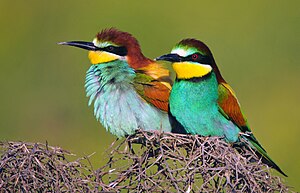Bee-eater (family)
| Bee-eater | ||||||||
|---|---|---|---|---|---|---|---|---|

Bee-eater ( Merops apiaster ), the only species of the family in Europe |
||||||||
| Systematics | ||||||||
|
||||||||
| Scientific name | ||||||||
| Meropidae | ||||||||
| Rafinesque , 1815 |
The bee-eaters or spinach (Meropidae) form a family of medium-sized birds that are found in Africa, Western and Southern Europe, partly also in Central and Eastern Europe, the Middle East, South Asia, Southeast Asia, Australia and New Guinea . In pure desert areas, e.g. Bee-eaters do not occur, for example, in the Sahara or the Central Arabian desert , as well as in North, Central and South America. They are placed with the rackets (Coraciiformes).
features
Bee-eaters are small, very colored birds with green, blue and yellow tints dominating. The back side is usually darker than the belly side. Both sexes can hardly be distinguished from the outside. The trunk is elongated-oval, the neck short and thick. The beak is long and slender, laterally flattened and curved. The wings are long and pointed, the tail is also long. The legs are short, the feet are small.
Habitat and way of life
Most species of bee-eater live in open habitats, in savannas, open forests, forest edges, only a few species are inhabitants of dense forests. Bee-eaters specialize in large insect food. They lurk in wait for their prey, which is caught on the fly. Only the sapphire pint ( M. muelleri ) looks for food near the ground. Often bees and wasps are the preferred food. Bee-eaters have very different breeding behavior. Some species breed in solitary pairs, while others form large nesting colonies. The nests are built at the end of self-dug tunnels in sandy slopes. The clutch consists of two to seven eggs. Both parents, sometimes assisted by specimens from previous broods, take part in digging the tunnels, breeding and rearing the young. The young birds are featherless and completely helpless for the first 20 days of their life. After leaving the nest, their parents will only continue to feed them for a few days.
Genera and species
The family consists of 3 genera and 31 species .

-
Meropogon Bonaparte 1850
- Celebespint ( M. forsteni )
-
Merops Linnaeus 1758
- White-throated Spint ( M. albicollis )
- Red-headed Spint ( M. americanus )
- Bee-eater ( M. apiaster )
- Boehmspint ( M. boehmi )
- Schwarzkopfspint ( M. breweri )
- Grünstirnspint ( M. bulocki )
- White- fronted Spint ( M. bullockoides )
- Arabian Emerald Spinach ( M. cyanophris )
- Purple pint ( M. gularis )
- Swallowtail moth ( M. hirundineus )
- Highland spint ( M. lafresnayii )
- Brown-headed pint ( M. leschenaulti )
- Rose spint ( M. malimbicus )
- Turquoise mustache ( M. mentalis )
- Sapphire pin ( M. muelleri )
- Scarlet Spint ( M. nubicoides )
- Carmine pint ( M. nubicus )
- Mountain Spint or Black Breast Spint ( M. oreobates )
- Emerald Spint ( M. orientalis )
- Rainbow spint ( M. ornatus )
- Blue-cheeked pint ( M. persicus )
- Blue-tailed pint ( Merops philippinus )
- Miniature pint ( M. pusillus )
- Somali spint ( M. revoilii )
- Madagascar spint ( M. superciliosus )
- Blue Breast Spint ( M. variegatus )
- Malay spint ( M. viridis )
- African emerald spint ( M. viridissimus )
-
Night spinning machine ( Nyctyornis Jardine & Selby 1830)
- Red Beard Spint ( N. amictus )
- Bluebeard Spint (
The forest-dwelling night spiders ( Nyctyornis ) are the sister group of all other bee-eaters and were sometimes separated as a separate family Nyctyornithidae.
supporting documents
- ↑ a b c d e David W. Winkler, Shawn M. Billerman, Irby J. Lovette: Bird Families of the World - An Invitation to the Spectacular Diversity of Birds. Lynx Edicions and the Cornell Lab of Ornithology, 2015, ISBN 978-84-941892-0-3 . Page 221 a. 222.


